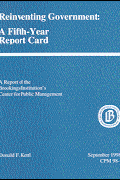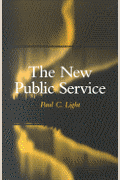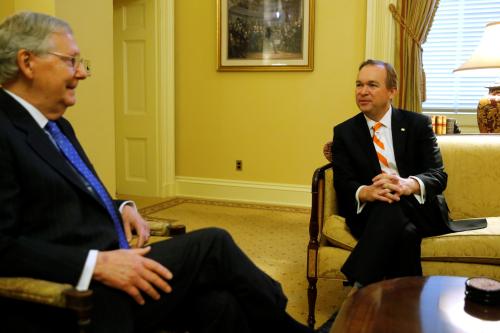This post is part of a series on the need for government reform and how to get it done. For more on this topic, visit the series page.
If Joe Biden is elected president and the federal government is to meet rising public concerns for faithful execution, he must make reform part of his agenda. It is one thing for him to promise a twenty-first-century government that is open and competent, as so many candidates have over the years. It is quite another to offer specifics on the size and cause of problems and provide a clear list of possible solutions that might help the government deliver on presidential promises. Consider five commitments toward that goal. And while these ideas are more likely to be implemented under a Biden administration—given President Trump’s disinterest in such approaches during his first four years—the same ideas would be useful if the president were reelected and opted to shift dramatically in his approach to a government reform agenda.
1. Expand the make-government-work-for-the-people plan to include government performance
Biden’s campaign and lobbying reforms are unlikely to affect day-to-day government performance unless he commits to deep bureaucratic repairs. Americans agree that campaign spending is too high and special interests too strong, but the way to make government work for the people is to give it the resources and authority to do the job well. Biden should also promise to eliminate the backlog of high-risk problems that continue to undermine federal performance, while reinforcing and extending the Obama administration’s commitment to evidence-based policymaking.
2. Reinforce the ethics system to protect against deceit
Dismantlers and rebuilders are more likely than other Americans to believe that special interests run the country, and they blame both parties for the horror stories about members of Congress and presidential aides who engage in misconduct. They know the legislative process is broken and want it fixed. Call it worse than it looks, worse than you think, or even the worst of the worst, the two groups want an end to insider dealing and the gridlock it produces. They also want effective federal oversight offices, starting with the Office of Government Ethics and Offices of Inspector General.
3. Reinvent government, again by streamlining the organization chart
The Biden campaign can find a perfect outline of how to reinvent government again at the University of West Texas “cyber-cemetery.” That is where Gore’s reinventing government papers are archived. Although Gore’s reinventors made significant progress in their first few years, the campaign slowed down with Clinton’s fall from grace.
Gore’s long-running reform campaign was widely caricatured at the time as a paradise for bureaucratic wonks and dreamers, but it generated an impressive list of impacts. “We cut government the right way by eliminating what wasn’t needed,” says Gore’s top reinventing aide, Elaine Kamarck, of the bloated hierarchies, duplication, obsolete field offices, needless regulations, and antiquated systems that grew the kudzu strangling federal innovation and productivity. Kamarck endorsed another round of reinventing early in Trump’s first term: “It is time to review the government again and ask the hard questions about what it’s doing and what it should be doing. And it is time to focus on obsolete functions and getting rid of them.” She is right.
4. Squash the Plum Book
Most presidential appointees are fully committed to faithfully executing the laws, but their growing numbers create opportunities for misconduct and inefficiency. Biden would do well to swear off the traditional addiction to political plums by promising to eliminate half of the “at-will” positions currently listed in the leadership directories (commonly referred to as the Plum Book). Doing so would draw a sharp contrast with the Trump administration’s use of every available slot to enforce party discipline deep into the federal hierarchy.
Along the way, Biden should demand a head-to-head inventory of the workforce—how else to manage it?[1] Congress and the president could call on the U.S. Office of Personnel Management for detailed information on every employee in the government, including hiring dates, promotions, job switches, and performance evaluation; however, that would only be part of the battle. They would still have no idea about the employees who show up to work under contracts and grants.
5. Rebuild the public service
The past two years have been especially punishing for the federal public service, and not just because of the shutdown in the winter of 2018–19. As former Federal Reserve Board Chairman and founder of the Volcker Alliance, Paul A. Volcker and I argued soon after that shutdown ended, the federal workforce needs immediate action as its workforce ages and the competition for talent increases:
Congress and the president must repair the federal government’s outdated personnel system. It has been forty years since Congress and President Carter inked the last major civil service reform, and the ossification is taking its toll on productivity and retention.
- Congress and the president must reassure young Americans that the federal government is a good place to work. The millennials and Gen Zs are not saying “show me the money” but rather, “show me the impact.”
- Democrats and Republicans must work to restore “regular order” in the federal budgeting process. There will always be an element of brinksmanship and uncertainty associated with the appropriations process, but the use of shutdown budgeting must end.
- Biden must honor the federal government’s pledge to fund the Public Service Loan Forgiveness Program by addressing continued mismanagement at the Department of Education.
- Congress and the president must make implementation a bigger issue in the policy process. As long as our leaders work to design and enact “high policy” such as the Affordable Care Act and immigration reform, they devote negligible attention to the nut and bolts of action.[2]
Volcker dedicated his life to calling the nation’s best and brightest to public service. It is the perfect time for Biden to start drafting a law built around Paul A. Volcker’s long commitment to public service reform. Naming a statute for the chairman of two historic national commissions on public service would not just honor promises to make government work for the people, it would encourage Americans to give the federal government the chance to regain their trust.
6. Try Common Sense
If vision without execution is hallucination, as Mr. Volcker often said, execution without vision is bureaucratic sloth. As public administration scholar Philip K. Howard contends, effective government flourishes with policies based on the human capacity to make appropriate decisions for the public good. Instead of relying on “bureaucratic verbiage,” Howard urges the federal government to embrace a “new operating philosophy built on the bedrock of individual responsibility and accountability.”[3]
Acknowledgments: I am grateful to my research team and many colleagues for their help in collecting, analyzing, and interpreting the data presented in this report. Of special note are my colleagues at New York University, especially my lead research scientist in the effort, Jie Ding, the survey team at SSRS, Nick Taborek at Nation Analytics, John Hudak, Christine Stenglein and my many colleagues at the Brookings Institution Center for Effective Public Management, and the Volcker Alliance team that shepherded so much of my past work on the topics presented here.
[1] The need for careful accounting was highlighted by then Rep. Chris Van Hollen (D-MD) in late 2014 in a tense House Budget Committee meeting as the committee began debating a cut in the number of federal employees. Pushed forward by the Association of Federal Government Employees (AFGE), Van Hollen asked the Congressional Budget Office enlighten the debate by providing a side-by-side analysis of budget savings from reductions in the number of federal and contractors: “I ask that when future reports include options to reduce the number of federal employees that they also consider options to achieve savings in the contracted workforce. This would allow Congress to consider tradeoffs between all aspects of government operations.” CBO refused the request, noting that it was unaware of any comprehensive database that contained the information, which was why Van Hollen asked the agency to build it. This exchange was summarized in an AFGE newsletter on December 11, 2014.
It is useful to note that the methodologies used to generate estimates of contract and grant employment for this report had already been tested in a 2006 report from my Organizational Performance Initiative. See Paul C. Light, “The New True Size of Government,” The Organizational Performance Initiative, New York University, Robert F. Wagner School of Public Service, August 2006.
[2] Americans showed strong support for the public service during the historical government shutdown in late 2018, but have long viewed government as a good place to work and often cited as positives the pay, job security, chance to make a difference, and helping people in need. Moreover, when asked whether they would like to see their child pursue a career in government, roughly half of Americans endorse the choice. Not surprisingly, dismantlers have been the most likely to answer “no” to that question over the years, while streamliners, rebuilders, and expanders have been more favorable. In 2016, for example, 66 percent of dismantlers said “no,” while 45 percent of streamliners, 52 percent of rebuilders, and 65 percent of expanders said “yes.” For the recent trend line on this question, see the Pew Research Center’s 2015 survey, Beyond Distrust, page 42. According to Pew, support for a career in government rose from 43 percent in 1997 to 56 percent in 2010 before dropping to 48 percent in 2015. My 2016 survey showed a further drop to 44 percent, a move that was likely a response to polarization surrounding the 2016 campaign.
[3] Philip K. Howard, Try Common Sense: Replacing the Failed Ideologies of Right and Left, (New York: W.W. Norton, 2019), 161.










Commentary
The six government reforms we need in 2021
October 14, 2020